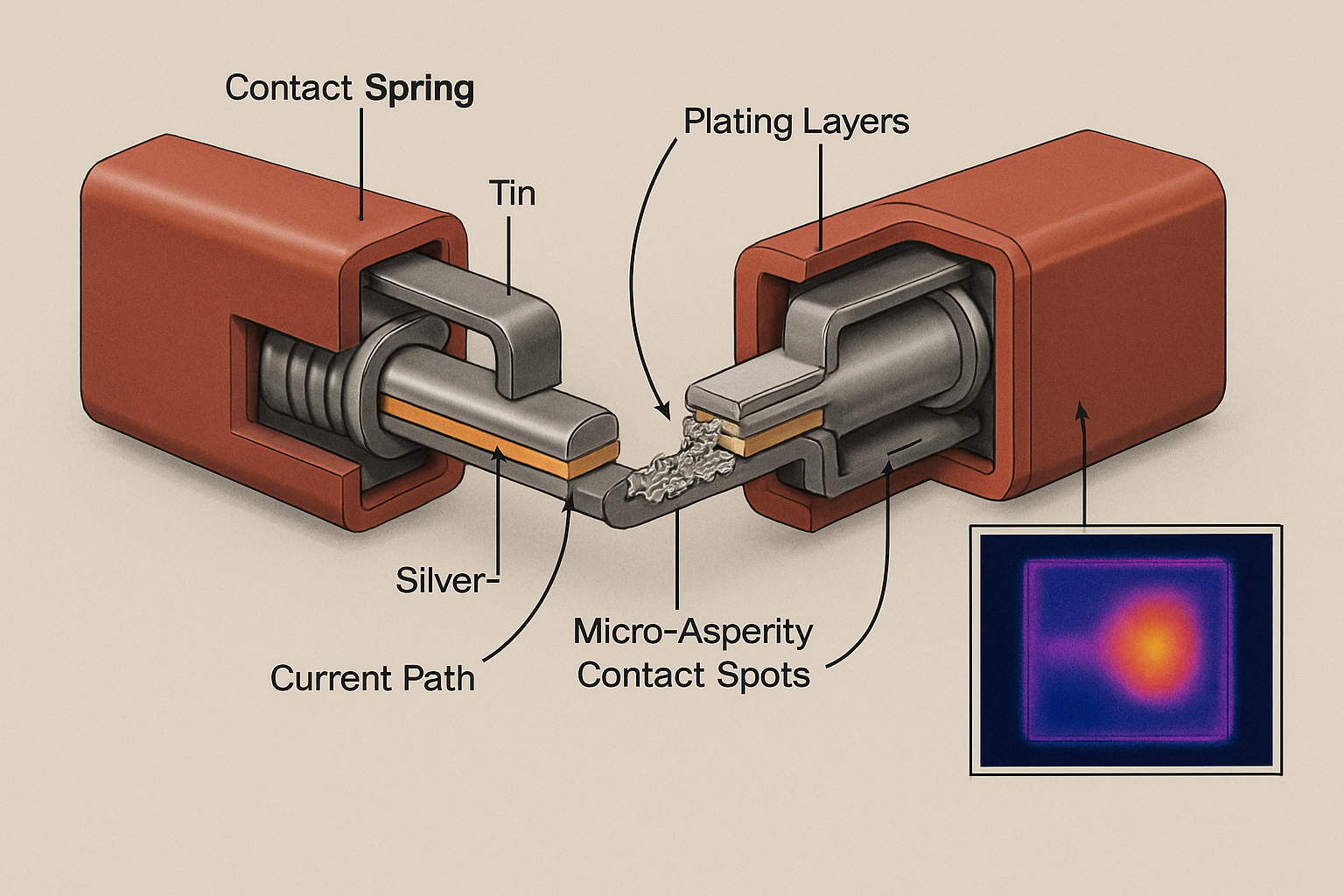Hot connectors are not a nuisance—they are an electrical fault in the making. From PV strings to portable kits and ESS wiring, I’ve traced most “mysterious heat” to just two levers: contact resistance and how we install and cool the terminations. Below I share data-backed causes, practical thresholds, and a step-by-step fix you can reproduce.
Why connectors run hot
I²R heating is the root
Heating follows P = I² × R. Double current and you quadruple heat. Even a few milliohms at the mating interface will turn 20–60 A DC into watts of loss that must leave through plastic housings and copper. Poor airflow and high ambient slow that cooling.
Contact resistance grows with wear and error
- Micro-fretting and oxidation raise resistance at the plating.
- Bad crimps (wrong die, under-crimp, clipped strands) add series milliohms.
- Partial insertion or latch wear cuts the true contact area.
- Contamination (dust, salt mist) and plating loss accelerate early heat rise.
Because heat increases resistance, a connector can run away thermally if the fault is not removed.
Load, ambient, and installation choices matter
- Running near the nameplate current leaves little thermal margin.
- High ambient (rooftops, battery enclosures) elevates the starting point.
- Bundled cables and tight conduits reduce convection around the shell.
- Undersized conductors boost voltage drop and concentrate heating at terminations.
My rule in the field: de-rate when ambient exceeds ~45 °C and avoid dense bundling near connectors; a single wire-size increase often cuts both drop and connector stress.
The numbers that separate safe from risky
Connectors are qualified so that temperature rise stays within limits at rated current (always follow the datasheet). In portable/PV duty, a practical target many engineers use is keeping housing rise under ~30 K with no softening or discoloration.
Back-of-envelope you can repeat
Assume an illustrative thermal resistance to air of ~20 K/W for a small plug in still air (example value for reasoning):
| Current (A) | Contact R (mΩ) | Heat P=I²R (W) | Approx. ΔT (K) |
|---|---|---|---|
| 30 | 0.5 | 0.45 | ≈ 9 |
| 30 | 1.0 | 0.90 | ≈ 18 |
| 30 | 2.0 | 1.80 | ≈ 36 |
| 30 | 3.0 | 2.70 | ≈ 54 |
Takeaway: moving from 1 mΩ to 2 mΩ can push a connector past a safe rise—common after corrosion or a poor crimp. On 48 V LiFePO₄ inverters drawing 60–120 A, margins tighten further.
Common causes and the targeted fix
| Cause | Symptoms | Quick check | Action |
|---|---|---|---|
| Poor crimp/termination | Warmth at cable entrance; pull-out risk | 4-wire milliohm across crimp; visual “bird-caging” | Re-terminate with the specified die, strip length, and gauge; verify pull/ohms |
| Partial mating / worn latch | Intermittent heat spikes; pitting marks | Insertion depth; positive click | Replace both halves; ensure full engagement and strain relief |
| Oxidation/corrosion | High ΔT at modest current | Discoloration; rising resistance | Replace contacts; improve sealing/routing; avoid salt spray |
| Undersized wire / long run | Hot cable and ends; high V-drop | Measure drop under load | Upsize conductor; shorten route; separate from hot surfaces |
| High ambient / poor airflow | Hot only at midday or in boxes | Compare vs ambient profile | De-rate; add spacing/vents; avoid bundles |
| Cross-family mating | Subtle misfit; chronic ΔT | Check part family and geometry | Use matched pairs; replace mismatched parts |
A stepwise repair that works
1) Stabilize and measure
- De-energize safely. DC sustains arcs; cover modules and isolate batteries.
- Re-energize with a steady load; log shell temperature vs ambient for 10–15 minutes. Keep IR emissivity consistent for accuracy.
- If rise exceeds ~25–30 K at rated current—or any melting/odor appears—replace the connector immediately.
2) Restore low resistance
- Cut back to bright copper if the strands are dark/pitted.
- Crimp using the manufacturer’s die and cavity; no nicked strands or burrs. Verify with a pull test and a milliohm reading.
- Mate new, matched connectors until a firm click; add strain relief. Avoid lubricants unless the datasheet explicitly permits them.
3) Reduce thermal stress
- Upsize wire gauge to reduce I²R and voltage drop at peak current.
- Keep connectors away from hot backsheets and battery cans; avoid bundling.





Leave a comment
All comments are moderated before being published.
This site is protected by hCaptcha and the hCaptcha Privacy Policy and Terms of Service apply.